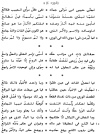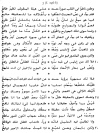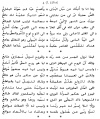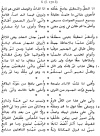
Sacred Texts Islam Index Previous Next
Buy this Book at Amazon.com


Studies in Islamic Mysticism, by Reynold A. Nicholson, [1921], at sacred-texts.com
Mention has been made (p. 99, note 2 supra) of Jílí's ode entitled al-Nawádiru ’l-‘ ayniyya fi ’l-bawádiri ’l-ghaybiyya. In the Insánu ’l-Kámil he cites 36 of its 534 verses (I. 30, 3; 39, 6 fr. foot; 52, 17; 66, 19; and 76, 15) and describes it as a magnificent and unique composition, too sublime to be fully understood. It is, however, little more than a versified summary of matter set forth in the Insánu ’l-Kámil, though in some instances the author expresses himself with a freedom and boldness which would hardly be tolerated in a prose treatise. As a poem, apart from its ungraceful style, it suffers from expounding a theory of mystical philosophy and cannot bear comparison with Ibnu ’l-Fáriḍ's Tá’iyya—the poetry of pure mysticism. The extracts given below have been copied from a manuscript in the British Museum (Or. 3684; Rieu's Suppl. to the Catalogue of Arabic MSS. No. 245) containing the text together with a commentary by ‘Abdu ’l-Ghaní al-Nábulusí.

Click to enlarge
1 (f. 130 b)
v. ٢. Instead of "there is no god but Allah" the poet says, "there is nothing but Absolute Beauty (jamál) and phenomenal beauty (ḥusn)," these being the inward and outward aspects of the Beloved.

Click to enlarge
2 (f. 139 b)
vv. ٧–٦. The individualisations of the Divine Essence are named "the creatures of God," but in reality they are no other than the Essence itself.

Click to enlarge
3 (f. 146 b)
v. ٢٠. The rhyme in this poem is muqayyad. Even Jílí could not have written
 here, or
here, or
 , (4, v. ٢٢). He neglects the rule that in this form of Ṭawíl the third foot of the second hemistich should be ̆ ̄ ̆ (not ̆ ̄ ̄).
, (4, v. ٢٢). He neglects the rule that in this form of Ṭawíl the third foot of the second hemistich should be ̆ ̄ ̆ (not ̆ ̄ ̄).

Click to enlarge
4 (f. 156 a)
v. ٦. MS.
 . Cf. p. 123 supra.
. Cf. p. 123 supra.
v. ٨ foll. The terms "ascent" and "descent" are improperly applied to the spirit, which has its being in God (
 in v. ١. means
in v. ١. means
 ). In order to distinguish it from God, we say that it is particularised and individualised, i.e. created; and we give the name of "spirit" to this individualisation, by means of which God displays Himself as in a mirror.
). In order to distinguish it from God, we say that it is particularised and individualised, i.e. created; and we give the name of "spirit" to this individualisation, by means of which God displays Himself as in a mirror.
v. ١٤.
 is a correction of the MS. reading
is a correction of the MS. reading
 .
.

Click to enlarge
4 (f. 156 a) (cont.)

Click to enlarge
5 (f. 161 b)
v. ٢ foll. Cf. p. 151 infra.
v. ١٢ foll. Cf. p. 126 supra.

Click to enlarge
5 (f. 161 b) (cont.)

Click to enlarge
6 (f. 170 b)